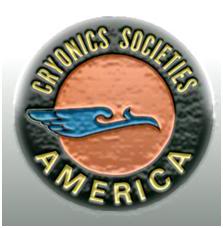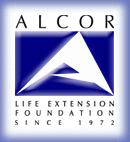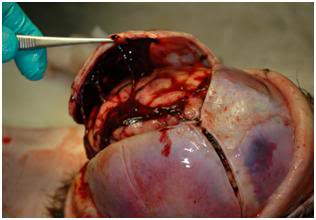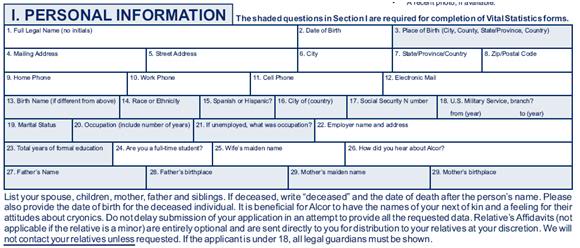By Mike Darwin
Defining the Cryonics Organization
 When cryonics began in the 1960s, the mission of the 4 cryonics societies[1] that more or less simultaneously came into existence at that time was fairly homogenous:
When cryonics began in the 1960s, the mission of the 4 cryonics societies[1] that more or less simultaneously came into existence at that time was fairly homogenous:
1) Make cryopreservation available to their members using the most advanced techniques available while seeking to minimize any post-cardiac arrest ischemic injury, and to continue and defend the cryopreservation of members until such time as resuscitation becomes possible (i.e., indefinitely),
2) Support scientific research to advance and perfect cryopreservation methods, and to generally support research in biomedicine that would facilitate resuscitation of cryopreserved patients,
3) Promote cryonics to the general public and the professions as a potentially viable mechanism for medical time travel,
4) Foster research into interventive gerontology and life span extension and work to extend the lives of members and conserve their health, delaying cryopreservation as long as possible,
5) Rehabilitate and reintegrate their cryopatients into the society or culture extant at the time that revival becomes feasible.
 During the 1980s, and continuing throughout the 1990s, divergence from this model began to occur. In particular, the Cryonics Institute began to define its services and activities around a low cost model which emphasized a simplified cryopreservation procedure with minimal/no emphasis on avoiding warm or cold ischemic injury and withdrawal from any interface with or intervention in the member’s medical care. In this model of cryonics, the cryonics organization becomes actively involved only after medico-legal death has been pronounced and a licensed Funeral Director takes custody of the patient and makes the removal from the home, hospital, ECF, or facility where the patient was pronounced legally dead. CI members can elect to have Standby and Stabilization services through a third party service provider, such as Suspended Animation, Inc., of Boynton Beach, FL, though the majority of CI members do not make such arrangements.[19]
During the 1980s, and continuing throughout the 1990s, divergence from this model began to occur. In particular, the Cryonics Institute began to define its services and activities around a low cost model which emphasized a simplified cryopreservation procedure with minimal/no emphasis on avoiding warm or cold ischemic injury and withdrawal from any interface with or intervention in the member’s medical care. In this model of cryonics, the cryonics organization becomes actively involved only after medico-legal death has been pronounced and a licensed Funeral Director takes custody of the patient and makes the removal from the home, hospital, ECF, or facility where the patient was pronounced legally dead. CI members can elect to have Standby and Stabilization services through a third party service provider, such as Suspended Animation, Inc., of Boynton Beach, FL, though the majority of CI members do not make such arrangements.[19]
 Alcor has continued to follow the prototypical cryonics society model to a greater degree, but appears to be no longer actively involved in trying to extend its members’ life spans by promoting risk reduction or health maintenance strategies, and it also appears to have ceded its activity in supporting and promoting interventive gerontological research to other organizations.[20] Contemporary cryonics organizations have thus effectively chosen to confine the scope of their operations to cryopreserving and storing their members, with or without aggressive attention to minimizing ischemic injury. Understanding these distinctions is crucial in any attempt to evaluate the performance of individual cryonics organizations, or of their service provider(s).
Alcor has continued to follow the prototypical cryonics society model to a greater degree, but appears to be no longer actively involved in trying to extend its members’ life spans by promoting risk reduction or health maintenance strategies, and it also appears to have ceded its activity in supporting and promoting interventive gerontological research to other organizations.[20] Contemporary cryonics organizations have thus effectively chosen to confine the scope of their operations to cryopreserving and storing their members, with or without aggressive attention to minimizing ischemic injury. Understanding these distinctions is crucial in any attempt to evaluate the performance of individual cryonics organizations, or of their service provider(s).
Measuring Quality in Cryonics
The easiest place to start in the case of trying to measure the quality of care in cryonics is at the beginning. That’s because the initial phases of the procedure very closely overlap conventional medical procedures, where hundreds of millions of dollars and countless man-years of effort have been expended developing both direct and surrogate feedback for the effectiveness of the procedures used. It might be expected that I am now about to launch into a discussion of the mechanics of providing closed-chest and extracorporeal circulatory support, or the induction of hypothermia. In fact, these interventions occur considerably downstream from the point where truly effective care of the cryopatient actually (ideally) begins.
In a very real sense, that care starts the moment the member/patient experiences his first contact with the cryonics organization that will ultimately cryopreserve him. The tenor of that first contact will likely determine the nature and course of the member’s subsequent interaction both with cryonics and his cryonics organization. If cryonics is presented as a developed product that is costly but nevertheless fairly routine, say like buying a home or an automobile, that’s very likely how it will be subsequently be treated. If, on the other hand, there is heavy emphasis on the lack of infrastructure to provide help in an emergency and the need to exercise both personal responsibility and personal preparedness, outcomes will likely differ – at least statistically, if not in each individual case.
It isn’t necessary for the reader to agree with all the criteria I am about to set out, although if you do not agree with any of them, then this article clearly isn’t for you, and you may stop reading at that point. It also isn’t the case that I’m going to cover all the bases here. To my knowledge, this is the first time that such an effort has been undertaken, and I am guaranteed to omit important elements of good care, as well as to include some which are superfluous. This is a draft document, input is welcome (indeed essential), and if it is to have any meaningful effect on the course of affairs in cryonics, this document will have to become an organic one – something that interacts dynamically and intelligently with the community it seeks to serve.
First Contact
 First contact with a cryonics organization by a Prospective Member (PM) usually occurs in one of three ways: via the organization’s website, through printed literature designed for recruitment, or through a phone call to the organization’s representative(s). The critical elements which must be present in that first contact (depending upon the willingness of the PM) are:
First contact with a cryonics organization by a Prospective Member (PM) usually occurs in one of three ways: via the organization’s website, through printed literature designed for recruitment, or through a phone call to the organization’s representative(s). The critical elements which must be present in that first contact (depending upon the willingness of the PM) are:
1) If the contact is by phone or in person, is there a systematic procedure for establishing the level of understanding the PM has about cryonics? For instance, does the PM understand that the procedure is speculative, that it is not currently reversible (i.e., not suspended animation) and may never be, that it is not currently consistent with established medical and mortuary practice and that cooperation, or even non-interference by these institutions, may not be forthcoming? Do they understand the likely costs, and the general uncertainties that accompany choosing cryonics as a life extending option?
2) Is a printed handbook available which comprehensively discusses the following issues:
a) Definition and history of cryonics, which is understood to include a narrative of cryonics, including its origin, significant historical milestones (e.g., the cryopreservation of the first man, Chatsworth, legal and cryobiological milestones, and so on) and its current status.
b) Explication and discussion of the various criteria for defining life and death, and how these contrast with the information-theoretic criterion used by most contemporary cryonicists.
c) Discussion of the time-course of post-cardiac arrest biochemical and structural changes and how these are known to impact viability and to degrade tissue structures currently thought to be critical to encoding memory and personality; the likely determinants of personal identity.
d) Thorough explanation and discussion of the currently available cryopreservation modalities and what their limits are in preserving the structures thought to encode personal identity when applied under optimum conditions (i.e., straight freezing, low level cryoprotected freezing, moderate and high level cryoprotected freezing and vitrification and incomplete vitrification). Known kinds of injury must be discussed in detail and illustrated photographically in such a way that the layman can grasp the degree and extent of the damage.
e) What are the likely obstacles to optimum cryopreservation and their frequency of occurrence in the organization’s membership population? What are the ways that individual members can both assess and reduce their risks of suffering these kinds of complications?
f) What is the impact of the various complications or obstacles to optimum, or even severely compromised cryopreservation? What are the probable effects of varying periods of ischemia on subsequent cryoprotectant equilibration and the consequences of suboptimum cryoprotection on viability and ultrastructure? These examples should also be demonstrated graphically, using gross, histological and ultrastructural images of brain tissue from animals or humans cryopreserved under conditions which accurately simulate those being employed by the cryonics organization on its own patients.
g) Summary of the scientific literature and scientific evidence that supports the cryonics premise, as well as data which cast doubt on the workability of the procedure.
h) Exploration of the nature of personal identity and the controversies surrounding it and how these interact with the practice of cryonics. The literature should allow the PM to understand the spectrum of possible outcomes from cryopreservation, ranging from survival of the genome in the form of a clone to complete recovery of a continuing individual with memory and personality intact.
i) Explanation of various scenarios for repair of cryoinjury, reversal of age-associated, and other pathologies, and restoration of the patient to life, under both worst case and best case conditions.
j) The mechanics of the cryopreservation procedures the organization offers; whole body versus neuropreservation, Standby, Stabilization and Transport, Cryoprotective Perfusion, Deep Subzero Cooling and Long Term Cryogenic Care. Each of these procedures must be discussed in detail and illustrated with images that document the technology being used in such a way that the PM can understand its likely impact on himself and on his family and friends should it need to be applied in an attempt to save his life.
k) Thorough and complete explication of the legal and financial mechanisms, instruments and institutions that are being used to finance and maintain cryopreservation.
 l) Costs, including a complete listing of, and charges for the infrastructure, capital equipment, and consumables employed to place a patient into cryopreservation and maintain him, indefinitely, in that state. This is understood to include financial transparency with quarterly, or at least annually prepared financial reports, preferably audited being available to members or prospective members.
l) Costs, including a complete listing of, and charges for the infrastructure, capital equipment, and consumables employed to place a patient into cryopreservation and maintain him, indefinitely, in that state. This is understood to include financial transparency with quarterly, or at least annually prepared financial reports, preferably audited being available to members or prospective members.
m) Contingency plans for dealing with sociopolitical or economic upheaval or other changes that make the practice of cryonics problematic or impossible where the cryonics organization has its patient care (storage) facilities.
n) Explication of the terms and conditions under which cryopreservation arrangement can be terminated by either the member or the cryonics organization.
Perhaps the best example of this kind of comprehensive handbook was that published by the Alcor Life Extension Foundation in 1989, entitled Cryonics: Reaching for Tomorrow by Brian Wowk and Mike Darwin.[21]
Membership Years
Prospective members who become fully signed up members with cryopreservation arrangements must be continually educated both about the basics of cryonics (learning through repetition) and about changes and new developments in all spheres of the profession; medical, scientific, financial, legal, social and political.
Minimizing the Risk and Consequences of Sudden Cardiac Arrest (SCA)
Population studies, as well as a large number of prospective, randomized clinical trials have unequivocally established that the Mediterranean diet (also called the Cretan diet) is effective in increasing mean lifespan in humans [22-26] whilst dramatically reducing the burden of age associated degenerative diseases.[26-39] In fact, the Mediterranean diet (MD) is the only dietary intervention that has robust, Level I evidence-based support in the peer reviewed medical literature. It has been shown to dramatically reduce the incidence of the metabolic syndrome,[40-45] Type II diabetes,[46-55] atherosclerosis,[37, 38, 56-63] stroke, myocardial infarction,[60, 64-72] a number of cancers,[24, 73-86] and may reduce the incidence and severity of Alzheimer’s disease (AD) and some other age-associated dementias.[26, 87-100]
 Since Sudden Cardiac Arrest (SCA) and AD represent the two most common risks for information-theoretic death in cryonicists, advocacy of the MD by cryonics organizations, and continuing education of their members about the benefits of the MD should be a high priority for all cryonics organizations. Indeed, the quality and quantity of scientific evidence for the morbidity and mortality reducing effects of the MD are now sufficiently well established that it might well be argued that failure to advocate this intervention constitutes negligence.
Since Sudden Cardiac Arrest (SCA) and AD represent the two most common risks for information-theoretic death in cryonicists, advocacy of the MD by cryonics organizations, and continuing education of their members about the benefits of the MD should be a high priority for all cryonics organizations. Indeed, the quality and quantity of scientific evidence for the morbidity and mortality reducing effects of the MD are now sufficiently well established that it might well be argued that failure to advocate this intervention constitutes negligence.
 The cryonics organization also has an obligation to protect its members from the consequences of catastrophic sequelae resulting from sudden and unexpected medico-legal death. Such protection should include the existence and vigorous promotion of a cryonics emergency first aid program which empowers individual members and their families to act immediately in the event of sudden cardiac arrest (SCA) to initiate external cooling,[101-104] and where appropriate in the case of high risk members, to avail themselves of protection against undetected periods of prolonged warm ischemia by use of cardiac arrest and ‘man down’ detection systems and/or wearable or implantable defibrillators. [105]
The cryonics organization also has an obligation to protect its members from the consequences of catastrophic sequelae resulting from sudden and unexpected medico-legal death. Such protection should include the existence and vigorous promotion of a cryonics emergency first aid program which empowers individual members and their families to act immediately in the event of sudden cardiac arrest (SCA) to initiate external cooling,[101-104] and where appropriate in the case of high risk members, to avail themselves of protection against undetected periods of prolonged warm ischemia by use of cardiac arrest and ‘man down’ detection systems and/or wearable or implantable defibrillators. [105]
Since approximately 1/3rd of members will be at risk of becoming Coroner’s or Medical Examiners (C/ME) cases preparations to reduce the risk of autopsy and to minimize the injury inflicted should it occur must be in place. Long before a member becomes a C/ME case the cryonics organization has an obligation to collect information that will help reduce delay and improve the chances of a more favorable outcome. The first step in doing this is to structure the cryonics organization ‘Membership Application’ so that all the personal information necessary to allow completion of the Death Certificate is both collected and present in the first Section of the Membership Application as shown below:
 In addition to the member’s name, address, phone number and birth date, all 50 states and the US territories require additional information to complete the Death Certificate. This information is gathered for statistical purposes and is often difficult to acquire in a timely fashion at the time of legal death. Indeed, in a number of cases the author is familiar with, the next-of-kin did not know some of this information leading to long delays in completion of the Death Certificate and release of the member to the cryonics organization. The following is a list of all the information required by the states’ department of Vital Statistics. Not all of this information is required in every state; however, the list below covers the information required by the combined 50 US states and the US territories.
In addition to the member’s name, address, phone number and birth date, all 50 states and the US territories require additional information to complete the Death Certificate. This information is gathered for statistical purposes and is often difficult to acquire in a timely fashion at the time of legal death. Indeed, in a number of cases the author is familiar with, the next-of-kin did not know some of this information leading to long delays in completion of the Death Certificate and release of the member to the cryonics organization. The following is a list of all the information required by the states’ department of Vital Statistics. Not all of this information is required in every state; however, the list below covers the information required by the combined 50 US states and the US territories.
- Full Legal Name
- Street Address (residence). Note: This must be a physical address, not a P.O. Box or Rural Route Number in areas (typically rural) where this otherwise constitutes a legal address.
- Date of Birth
- Place of Birth: City, County, State/Province, Country
- Birth Name (if different from legal name)
- Race or Ethnicity
- Spanish or Hispanic
- City (of Country)
- Social Security Number
- U.S. Military Service, Branch, Dates Served (From and To)
- Marital Status
- Occupation (list number of years)
- If Unemployed what was Occupation
- Total years of education
- Father’s Name and Birthplace: City, County, State/Province, Country
- Mother Maiden Name and Birthplace: City, County, State/Province, Country
This information should be entered into the cryonics organization’s computerized database for rapid retrieval in the event it is needed. Paper copies should also be readily available at the cryonics organization’s headquarters in the event electronic access is not possible for some reason (power failure, IT difficulties, etc.).
End of Part 2
Footnote
[1] In order, they were the Cryonics Society of New York (CSNY), the Cryonics Society of California (CSC), the Cryonics Society of Michigan (CSM) and the Bay Area Cryonics Society (BACS). Of these, two organizations are still in existence, although using different names; CSM has become the Cryonics Institute (CI)/Immortalist Society (IS) and BACS is now the American Cryonics Society (ACS).
References
1. Federowicz M, et al.,: Perfusion and freezing of a 60-year old woman. Manrise Technical Review 1973, 3(1):7-32.
2. De Wolf A: Case reports in cryonics In: Depressed Metabolism. Portland: Depressed Metabolism; 2011.
3. Neff T: Routine oximetry. A fifth vital sign? . Chest 1988 94(2):227.
4. Tierney LJ, Whooley, MA, Saint, S.: Oxygen saturation: a fifth vital sign? West J Med 1997, 166(4):285-286.
5. Thilo E, Andersen, D, Wasserstein, ML, Schmidt, J, Luckey, D.: Saturation by pulse oximetry: comparison of the results obtained by instruments of different brands. . J Pediatr 1993, 122(4):620-626.
6. Clayton D, Webb, RK, Ralston, AC, Duthie, D, Runciman, WB.: A comparison of the performance of 20 pulse oximeters under conditions of poor perfusion. Anaesthesia 1991, 46(1):3-10.
7. Gehring H, Hornberger, C, Matz, H, Konecny, E, Schmucker, P.: The effects of motion artifact and low perfusion on the performance of a new generation of pulse oximeters in volunteers undergoing hypoxemia. Respir Care 2002, 47(1):48-60.
8. Schramm W, Bartunek, A, Gilly, H.: Effect of local limb temperature on pulse oximetry and the plethysmographic pulse wave. . Int J Clin Monit Comput 1997, 14(1):17-22.
9. Nishiyama T: Pulse oximeters demonstrate different responses during hypothermia and changes in perfusion. Can J Anaesth 2006, 53(2):136-138.
10. Bergersen T, Hisdal, J, Walløe, L.: Perfusion of the human finger during cold-induced vasodilatation. Am J Physiol 1999, 276((3 Pt 2)):R731-737.
11. Chen F, Liu, ZY, Holmér, I.: Hand and finger skin temperatures in convective and contact cold exposure. . Eur J Appl Physiol Occup Physiol 1996, 72(4):372-379.
12. O’Brien C, Montain, SJ.: Hypohydration effect on finger skin temperature and blood flow during cold-water finger immersion. . J Appl Physiol 2003, 94(2):598-603.
13. Pälve H, Vuori, A.: Pulse oximetry during low cardiac output and hypothermia states immediately after open heart surgery. Crit Care Med 1989, 17(1):66-69.
14. Polanco P, Pinsky, MR.: Practical issues of hemodynamic monitoring at the bedside. Surg Clin N Am 2006, 86:1431-1456.
15. Rea T, Eisenberg, MS, Sinibaldi G, White, RD.: Incidence of EMS-treated out-of-hospital cardiac arrest in the United States. Resuscitation 2004, 63:17-24.
16. Cummins R, Chamberlain, DA, Abramson, NS, et al.: Recommended guidelines for uniform reporting of data from out-of-hospital cardiac arrest: the Utstein Style. A statement for health professionals from a task force of the American Heart Association, the European Resuscitation Council, the Heart and Stroke Foundation of Canada, and the Australian Resuscitation Council. Circulation 1991, 84:960-975.
17. Eisenberg M, Cummins, RO, Larsen, MP.: Numerators, denominators, and survival rates: reporting survival from out-of-hospital cardiac arrest. . Am J Emerg Med 1991, 9:544-546.
18. Survive Cardiac Arrest [http://blacklistinc.com/survive/index.php]
19. Cryonics Institute: Comparing Procedures and Policies: http://cryonics.org/comparisons.html
20. Wowk B: About Alcor: http://www.alcor.org/AboutAlcor/index.html. 2003.
21. Wowk B, Darwin, M.: Cryonics Reaching for Tomorrow. Riverside: Alcor Life Extension Foundation; 1989.
22. Knoops KT, de Groot LC, Kromhout D, Perrin AE, Moreiras-Varela O, Menotti A, van Staveren WA: Mediterranean diet, lifestyle factors, and 10-year mortality in elderly European men and women: the HALE project. JAMA 2004, 292(12):1433-1439.
23. Lagiou P, Trichopoulos D, Sandin S, Lagiou A, Mucci L, Wolk A, Weiderpass E, Adami HO: Mediterranean dietary pattern and mortality among young women: a cohort study in Sweden. Br J Nutr 2006, 96(2):384-392.
24. Serra-Majem L, Roman B, Estruch R: Scientific evidence of interventions using the Mediterranean diet: a systematic review. Nutr Rev 2006, 64(2 Pt 2):S27-47.
25. Mitrou PN, Kipnis V, Thiebaut AC, Reedy J, Subar AF, Wirfalt E, Flood A, Mouw T, Hollenbeck AR, Leitzmann MF et al: Mediterranean dietary pattern and prediction of all-cause mortality in a US population: results from the NIH-AARP Diet and Health Study. Arch Intern Med 2007, 167(22):2461-2468.
26. Perez-Lopez FR, Chedraui P, Haya J, Cuadros JL: Effects of the Mediterranean diet on longevity and age-related morbid conditions. Maturitas 2009, 64(2):67-79.
27. Sofi F: The Mediterranean diet revisited: evidence of its effectiveness grows. Curr Opin Cardiol 2009, 24(5):442-446.
28. Proietti AR, del Balzo V, Dernini S, Donini LM, Cannella C: [Mediterranean diet and prevention of non-communicable diseases: scientific evidences]. Ann Ig 2009, 21(3):197-210.
29. Piscopo S: The Mediterranean diet as a nutrition education, health promotion and disease prevention tool. Public Health Nutr 2009, 12(9A):1648-1655.
30. Alonso A, Martinez-Gonzalez MA: Mediterranean diet, lifestyle factors, and mortality. JAMA 2005, 293(6):674; author reply 674-675.
31. Alonso A, Beunza JJ, Delgado-Rodriguez M, Martinez JA, Martinez-Gonzalez MA: Low-fat dairy consumption and reduced risk of hypertension: the Seguimiento Universidad de Navarra (SUN) cohort. Am J Clin Nutr 2005, 82(5):972-979.
32. Roman B, Carta L, Martinez-Gonzalez MA, Serra-Majem L: Effectiveness of the Mediterranean diet in the elderly. Clin Interv Aging 2008, 3(1):97-109.
33. Martinez-Gonzalez MA, Fernandez-Jarne E, Serrano-Martinez M, Marti A, Martinez JA, Martin-Moreno JM: Mediterranean diet and reduction in the risk of a first acute myocardial infarction: an operational healthy dietary score. Eur J Nutr 2002, 41(4):153-160.
34. Segui-Gomez M, de la Fuente C, Vazquez Z, de Irala J, Martinez-Gonzalez MA: Cohort profile: the ‘Seguimiento Universidad de Navarra’ (SUN) study. Int J Epidemiol 2006, 35(6):1417-1422.
35. Tortosa A, Bes-Rastrollo M, Sanchez-Villegas A, Basterra-Gortari FJ, Nunez-Cordoba JM, Martinez-Gonzalez MA: Mediterranean diet inversely associated with the incidence of metabolic syndrome: the SUN prospective cohort. Diabetes Care 2007, 30(11):2957-2959.
36. Nunez-Cordoba JM, Valencia-Serrano F, Toledo E, Alonso A, Martinez-Gonzalez MA: The Mediterranean diet and incidence of hypertension: the Seguimiento Universidad de Navarra (SUN) Study. Am J Epidemiol 2009, 169(3):339-346.
37. de Lorgeril M, Salen P: The Mediterranean diet: rationale and evidence for its benefit. Curr Atheroscler Rep 2008, 10(6):518-522.
38. de Lorgeril M, Salen P: Modified cretan Mediterranean diet in the prevention of coronary heart disease and cancer: An update. World Rev Nutr Diet 2007, 97:1-32.
39. Dalziel K, Segal L, de Lorgeril M: A mediterranean diet is cost-effective in patients with previous myocardial infarction. J Nutr 2006, 136(7):1879-1885.
40. Alvarez Leon EE, Henriquez P, Serra-Majem L: Mediterranean diet and metabolic syndrome: a cross-sectional study in the Canary Islands. Public Health Nutr 2006, 9(8A):1089-1098.
41. Babio N, Bullo M, Basora J, Martinez-Gonzalez MA, Fernandez-Ballart J, Marquez-Sandoval F, Molina C, Salas-Salvado J: Adherence to the Mediterranean diet and risk of metabolic syndrome and its components. Nutr Metab Cardiovasc Dis 2009, 19(8):563-570.
42. Babio N, Bullo M, Salas-Salvado J: Mediterranean diet and metabolic syndrome: the evidence. Public Health Nutr 2009, 12(9A):1607-1617.
43. Bullo M, Casas-Agustench P, Amigo-Correig P, Aranceta J, Salas-Salvado J: Inflammation, obesity and comorbidities: the role of diet. Public Health Nutr 2007, 10(10A):1164-1172.
44. Kastorini CM, Panagiotakos DB: The role of the mediterranean diet on the development of the metabolic syndrome. Front Biosci (Elite Ed), 2:1320-1333.
45. Urquiaga I, Echeverria G, Polic G, Castillo O, Liberona Y, Rozowski J, Perez D, Martinez C, Vasquez L, Strobel P et al: Mediterranean food and diets, global resource for the control of metabolic syndrome and chronic diseases. World Rev Nutr Diet 2008, 98:150-173.
46. Summaries for patients. The effects of a Mediterranean diet on the need for type 2 diabetes treatment. Ann Intern Med 2009, 151(5):I42.
47. Elhayany A, Lustman A, Abel R, Attal-Singer J, Vinker S: A low carbohydrate Mediterranean diet improves cardiovascular risk factors and diabetes control among overweight patients with type 2 diabetes mellitus: a 1-year prospective randomized intervention study. Diabetes Obes Metab, 12(3):204-209.
48. Dietary measures for type 2 diabetes. Weight loss and a Mediterranean-type diet, with no foods off-limits. Prescrire Int 2009, 18(103):224.
49. Basterra-Gortari FJ, Martinez-Gonzalez MA: Mediterranean diet in type 2 diabetes. Diabetologia 2008, 51(10):1933-1934; author reply 1935.
50. Biesalski HK: Diabetes preventive components in the Mediterranean diet. Eur J Nutr 2004, 43 Suppl 1:I/26-30.
51. Esposito K, Maiorino MI, Ceriello A, Giugliano D: Prevention and control of type 2 diabetes by Mediterranean diet: a systematic review. Diabetes Res Clin Pract, 89(2):97-102.
52. Martinez-Gonzalez MA, de la Fuente-Arrillaga C, Nunez-Cordoba JM, Basterra-Gortari FJ, Beunza JJ, Vazquez Z, Benito S, Tortosa A, Bes-Rastrollo M: Adherence to Mediterranean diet and risk of developing diabetes: prospective cohort study. BMJ 2008, 336(7657):1348-1351.
53. Schroder H: Protective mechanisms of the Mediterranean diet in obesity and type 2 diabetes. J Nutr Biochem 2007, 18(3):149-160.
54. Yan L: ‘Mediterranean lifestyles’ improve diabetes outcomes. Nephrol News Issues 2007, 21(4):21, 23.
55. Schiltz B, Minich DM, Lerman RH, Lamb JJ, Tripp ML, Bland JS: A science-based, clinically tested dietary approach for the metabolic syndrome. Metab Syndr Relat Disord 2009, 7(3):187-192.
56. Carter SJ, Roberts MB, Salter J, Eaton CB: Relationship between Mediterranean Diet Score and atherothrombotic risk: findings from the Third National Health and Nutrition Examination Survey (NHANES III), 1988-1994. Atherosclerosis, 210(2):630-636.
57. El-Sabban F, Abouazra H: Effect of garlic on atherosclerosis and its factors. East Mediterr Health J 2008, 14(1):195-205.
58. De Lorgeril M: Essential polyunsaturated fatty acids, inflammation, atherosclerosis and cardiovascular diseases. Subcell Biochem 2007, 42:283-297.
59. Massaro M, De Caterina R: Vasculoprotective effects of oleic acid: epidemiological background and direct vascular antiatherogenic properties. Nutr Metab Cardiovasc Dis 2002, 12(1):42-51.
60. Bendinelli B, Masala G, Saieva C, Salvini S, Calonico C, Sacerdote C, Agnoli C, Grioni S, Frasca G, Mattiello A et al: Fruit, vegetables, and olive oil and risk of coronary heart disease in Italian women: the EPICOR Study. Am J Clin Nutr, 93(2):275-283.
61. Dontas AS, Zerefos NS, Panagiotakos DB, Vlachou C, Valis DA: Mediterranean diet and prevention of coronary heart disease in the elderly. Clin Interv Aging 2007, 2(1):109-115.
62. Martin-Du Pan R: [Prevention of cardiovascular and degenerative diseases: II. Hormones and/or Mediterranean diet]. Rev Med Suisse Romande 2003, 123(3):183-189.
63. Trichopoulou A, Bamia C, Trichopoulos D: Anatomy of health effects of Mediterranean diet: Greek EPIC prospective cohort study. BMJ 2009, 338:b2337.
64. Barzi F, Woodward M, Marfisi RM, Tavazzi L, Valagussa F, Marchioli R: Mediterranean diet and all-causes mortality after myocardial infarction: results from the GISSI-Prevenzione trial. Eur J Clin Nutr 2003, 57(4):604-611.
65. Barzi F, Woodward M, Marfisi RM, Tognoni G, Marchioli R: Analysis of the benefits of a Mediterranean diet in the GISSI-Prevenzione study: a case study in imputation of missing values from repeated measurements. Eur J Epidemiol 2006, 21(1):15-24.
66. Buckland G, Gonzalez CA, Agudo A, Vilardell M, Berenguer A, Amiano P, Ardanaz E, Arriola L, Barricarte A, Basterretxea M et al: Adherence to the Mediterranean diet and risk of coronary heart disease in the Spanish EPIC Cohort Study. Am J Epidemiol 2009, 170(12):1518-1529.
67. Hu FB: The Mediterranean diet and mortality–olive oil and beyond. N Engl J Med 2003, 348(26):2595-2596.
68. Panagiotakos DB, Dimakopoulou K, Katsouyanni K, Bellander T, Grau M, Koenig W, Lanki T, Pistelli R, Schneider A, Peters A: Mediterranean diet and inflammatory response in myocardial infarction survivors. Int J Epidemiol 2009, 38(3):856-866.
69. Trichopoulou A, Bamia C, Norat T, Overvad K, Schmidt EB, Tjonneland A, Halkjaer J, Clavel-Chapelon F, Vercambre MN, Boutron-Ruault MC et al: Modified Mediterranean diet and survival after myocardial infarction: the EPIC-Elderly study. Eur J Epidemiol 2007, 22(12):871-881.
70. Bilenko N, Fraser D, Vardi H, Shai I, Shahar DR: Mediterranean diet and cardiovascular diseases in an Israeli population. Prev Med 2005, 40(3):299-305.
71. Tuttle KR, Shuler LA, Packard DP, Milton JE, Daratha KB, Bibus DM, Short RA: Comparison of low-fat versus Mediterranean-style dietary intervention after first myocardial infarction (from The Heart Institute of Spokane Diet Intervention and Evaluation Trial). Am J Cardiol 2008, 101(11):1523-1530.
72. Huang CL, Sumpio BE: Olive oil, the mediterranean diet, and cardiovascular health. J Am Coll Surg 2008, 207(3):407-416.
73. Menendez JA, Lupu R: Mediterranean dietary traditions for the molecular treatment of human cancer: anti-oncogenic actions of the main olive oil’s monounsaturated fatty acid oleic acid (18:1n-9). Curr Pharm Biotechnol 2006, 7(6):495-502.
74. Benetou V, Trichopoulou A, Orfanos P, Naska A, Lagiou P, Boffetta P, Trichopoulos D: Conformity to traditional Mediterranean diet and cancer incidence: the Greek EPIC cohort. Br J Cancer 2008, 99(1):191-195.
75. Bosetti C, Pelucchi C, La Vecchia C: Diet and cancer in Mediterranean countries: carbohydrates and fats. Public Health Nutr 2009, 12(9A):1595-1600.
76. Buckland G, Agudo A, Lujan L, Jakszyn P, Bueno-de-Mesquita HB, Palli D, Boeing H, Carneiro F, Krogh V, Sacerdote C et al: Adherence to a Mediterranean diet and risk of gastric adenocarcinoma within the European Prospective Investigation into Cancer and Nutrition (EPIC) cohort study. Am J Clin Nutr, 91(2):381-390.
77. Cassileth B: Mediterranean diet. Oncology (Williston Park) 2009, 23(14):1315.
78. Fortes C, Forastiere F, Farchi S, Mallone S, Trequattrinni T, Anatra F, Schmid G, Perucci CA: The protective effect of the Mediterranean diet on lung cancer. Nutr Cancer 2003, 46(1):30-37.
79. Fortes C, Mastroeni S, Melchi F, Pilla MA, Antonelli G, Camaioni D, Alotto M, Pasquini P: A protective effect of the Mediterranean diet for cutaneous melanoma. Int J Epidemiol 2008, 37(5):1018-1029.
80. Gallus S, Bosetti C, La Vecchia C: Mediterranean diet and cancer risk. Eur J Cancer Prev 2004, 13(5):447-452.
81. Fung TT, Hu FB, Wu K, Chiuve SE, Fuchs CS, Giovannucci E: The Mediterranean and Dietary Approaches to Stop Hypertension (DASH) diets and colorectal cancer. Am J Clin Nutr, 92(6):1429-1435.
82. Miano L: [Mediterranean diet, micronutrients and prostate carcinoma: a rationale approach to primary prevention of prostate cancer]. Arch Ital Urol Androl 2003, 75(3):166-178.
83. Siari S, Scali J, Richard A, Tretarre B, Daures JP, Padilla M, Grosclaude P, Gerber M: Subregional variations of dietary consumption and incidences of cancers in southern France. IARC Sci Publ 2002, 156:127-129.
84. Wahle KW, Caruso D, Ochoa JJ, Quiles JL: Olive oil and modulation of cell signaling in disease prevention. Lipids 2004, 39(12):1223-1231.
85. Visioli F, Grande S, Bogani P, Galli C: The role of antioxidants in the mediterranean diets: focus on cancer. Eur J Cancer Prev 2004, 13(4):337-343.
86. Dixon LB, Subar AF, Peters U, Weissfeld JL, Bresalier RS, Risch A, Schatzkin A, Hayes RB: Adherence to the USDA Food Guide, DASH Eating Plan, and Mediterranean dietary pattern reduces risk of colorectal adenoma. J Nutr 2007, 137(11):2443-2450.
87. Mediterranean diet may lower AD risk. Health News 2006, 12(7):11.
88. Eat Mediterranean-style to lower risk of AD, depression. A healthier diet improves vascular function and overall physical health=a healthier brain. Duke Med Health News 2009, 15(12):1-2.
89. Berr C, Portet F, Carriere I, Akbaraly TN, Feart C, Gourlet V, Combe N, Barberger-Gateau P, Ritchie K: Olive oil and cognition: results from the three-city study. Dement Geriatr Cogn Disord 2009, 28(4):357-364.
90. Feart C, Samieri C, Barberger-Gateau P: Mediterranean diet and cognitive function in older adults. Curr Opin Clin Nutr Metab Care, 13(1):14-18.
91. Galvin JE: Pass the grain; spare the brain. Neurology 2007, 69(11):1072-1073.
92. Kawas CH: Diet and the risk for Alzheimer’s disease. Ann Neurol 2006, 59(6):877-879.
93. Knopman DS: Mediterranean diet and late-life cognitive impairment: a taste of benefit. JAMA 2009, 302(6):686-687.
94. Lopez-Miranda J, Perez-Jimenez F, Ros E, De Caterina R, Badimon L, Covas MI, Escrich E, Ordovas JM, Soriguer F, Abia R et al: Olive oil and health: summary of the II international conference on olive oil and health consensus report, Jaen and Cordoba (Spain) 2008. Nutr Metab Cardiovasc Dis, 20(4):284-294.
95. Panza F, Capurso C, D’Introno A, Colacicco AM, Del Parigi A, Gagliardi G, Breglia G, Capurso A, Solfrizzi V: Mediterranean diet, mild cognitive impairment, and Alzheimer’s disease. Exp Gerontol 2007, 42(1-2):6-7; author reply 8-9.
96. Panza F, Solfrizzi V, Colacicco AM, D’Introno A, Capurso C, Torres F, Del Parigi A, Capurso S, Capurso A: Mediterranean diet and cognitive decline. Public Health Nutr 2004, 7(7):959-963.
97. Scarmeas N, Stern Y, Mayeux R, Luchsinger JA: Mediterranean diet, Alzheimer disease, and vascular mediation. Arch Neurol 2006, 63(12):1709-1717.
98. Sofi F, Macchi C, Abbate R, Gensini GF, Casini A: Effectiveness of the Mediterranean diet: can it help delay or prevent Alzheimer’s disease? J Alzheimers Dis, 20(3):795-801.
99. Solfrizzi V, Capurso C, D’Introno A, Colacicco AM, Chirico M, Capurso A, Panza F: Whole-diet approach, Mediterranean diet, and Alzheimer disease. Arch Neurol 2007, 64(4):606; author reply 607.
100. Solfrizzi V, Capurso C, Panza F: Adherence to a Mediterranean dietary pattern and risk of Alzheimer’s disease. Ann Neurol 2006, 60(5):620; author reply 621.
101. Darwin M: Last aid as first aid for cryonicists, Part 1: http://chronopause.com/index.php/2011/02/26/last-aid-as-first-aid-for-cryonicists-part-i/. In: Chronosphere. Munich: Chronopause Foundation; 2011.
102. Darwin M: Last aid as first aid for cryonicists, Part 2: http://chronopause.com/index.php/2011/03/01/last-aid-as-first-aid-for-cryonicists-part-2/. In: Chronosphere. Munich: Chronopause Foundation; 2011.
103. Darwin M: Last aid as first aid for cryonicists, Part 3: http://chronopause.com/index.php/2011/03/04/last-aid-as-first-aid-for-cryonicists-part-3/. In: Chronosphere. Munich: Chronopause Foundation; 2011.
104. Darwin M: Last aid as first aid for cryonicists, Part 4: http://chronopause.com/index.php/2011/03/06/last-aid-as-first-aid-for-cryonicists-part-4/. In: Chronosphere. Munich: Chronopause Foundation; 2011.
105. Darwin M: I Know this is Going to be Shocking: A Review of Wearable Continuous Monitoring Systems to Detect and Treat Sudden Cardiac Arrest in Cryonicists: http://chronopause.com/index.php/2011/03/16/i-know-this-is-going-to-be-shocking-a-review-of-wearable-continuous-monitoring-systems-to-detect-and-treat-sudden-cardiac-arrest-in-cryonicists/. In: Chronosphere. Munich: Chronopause Foundation; 2011.
